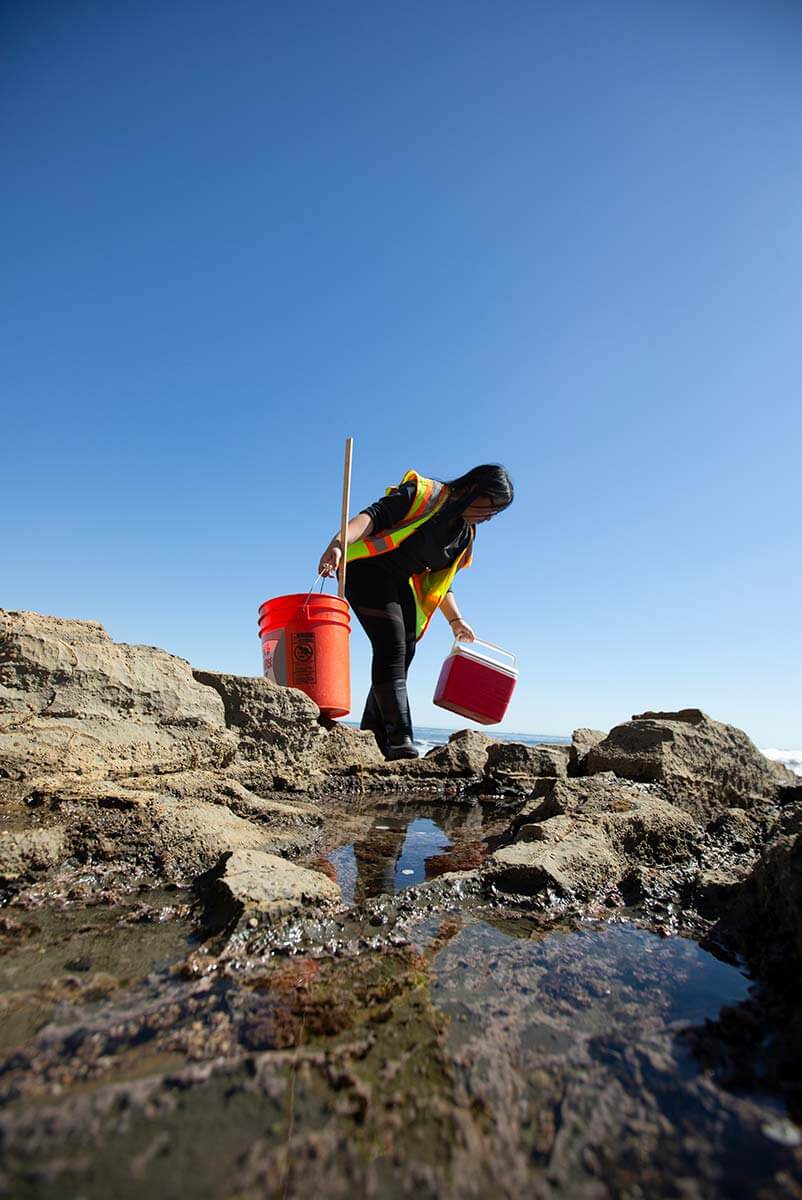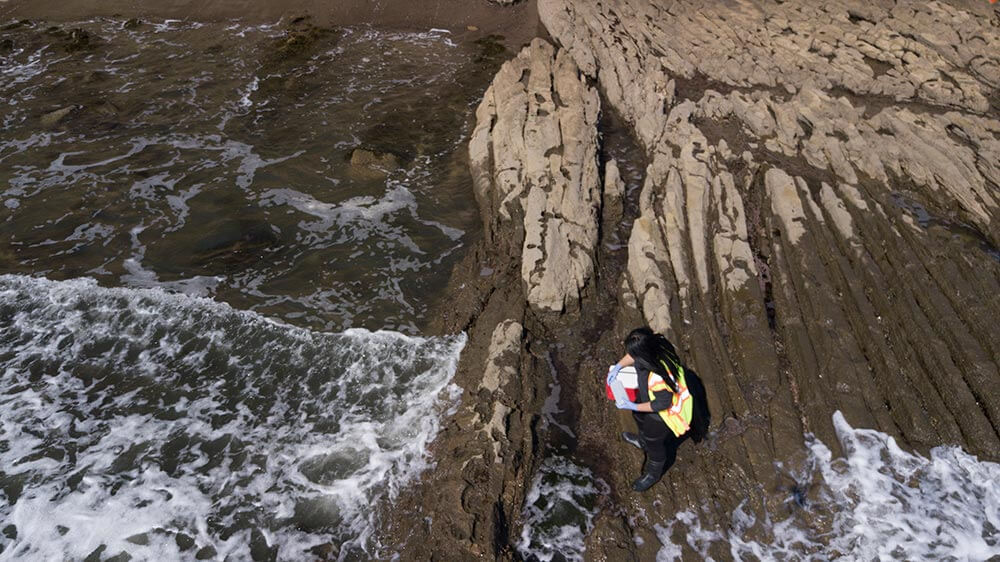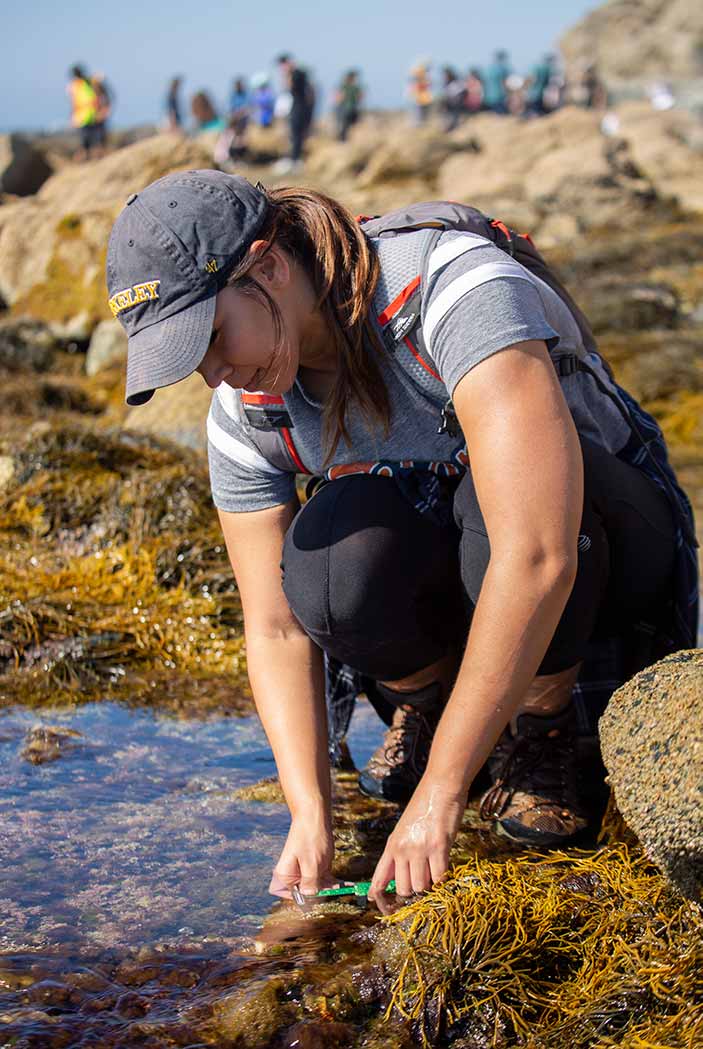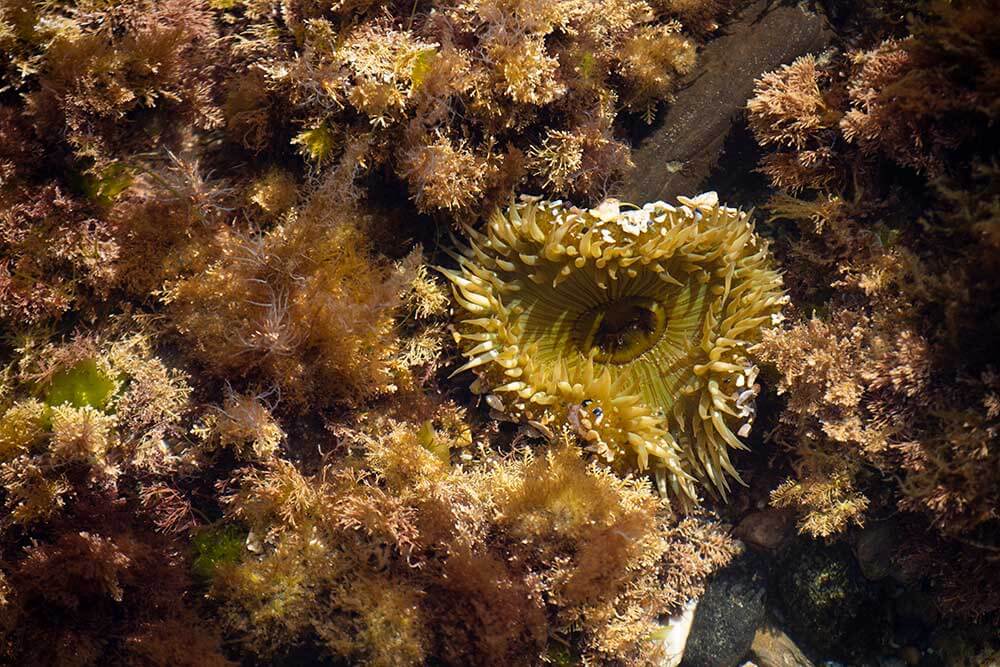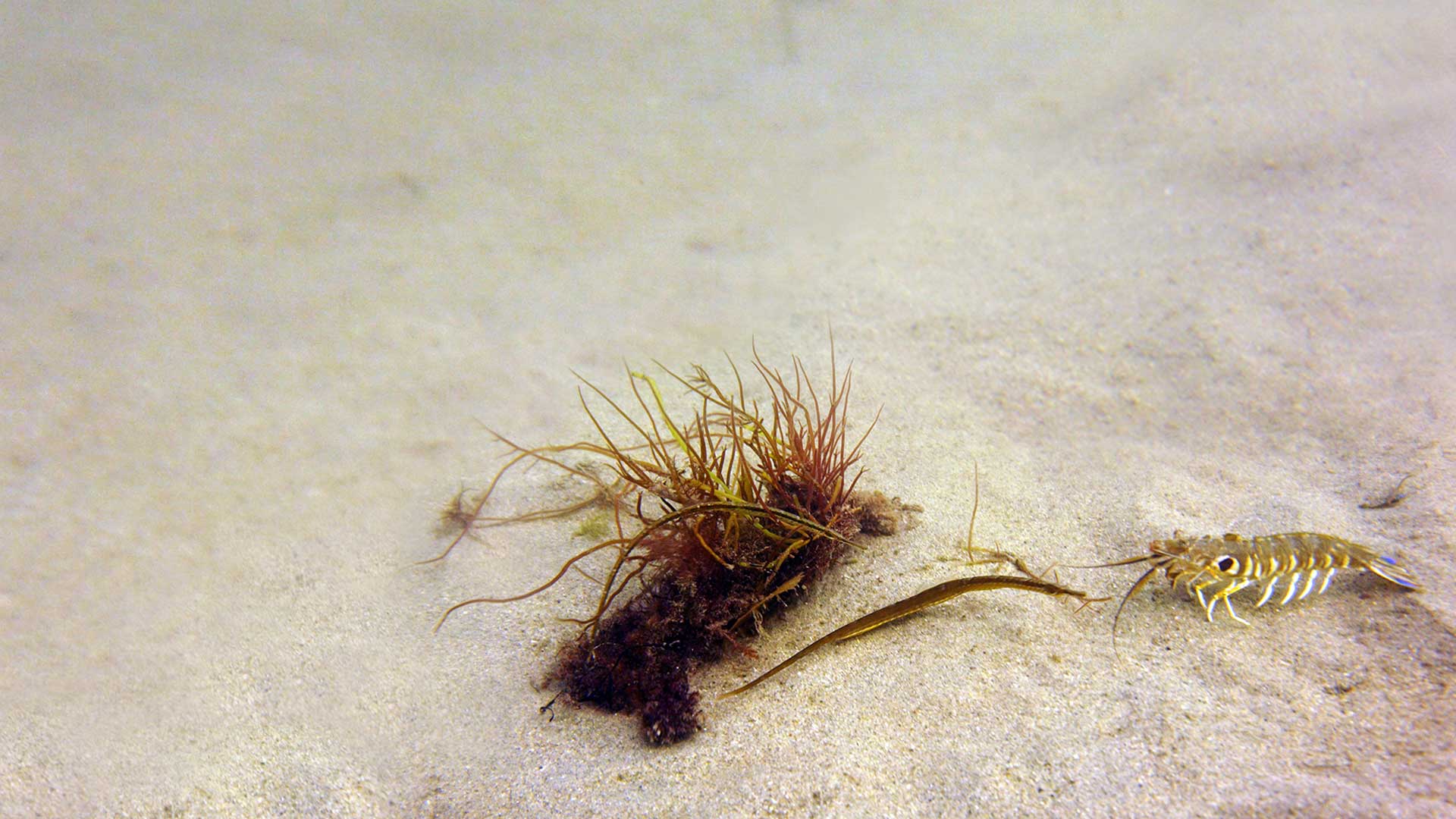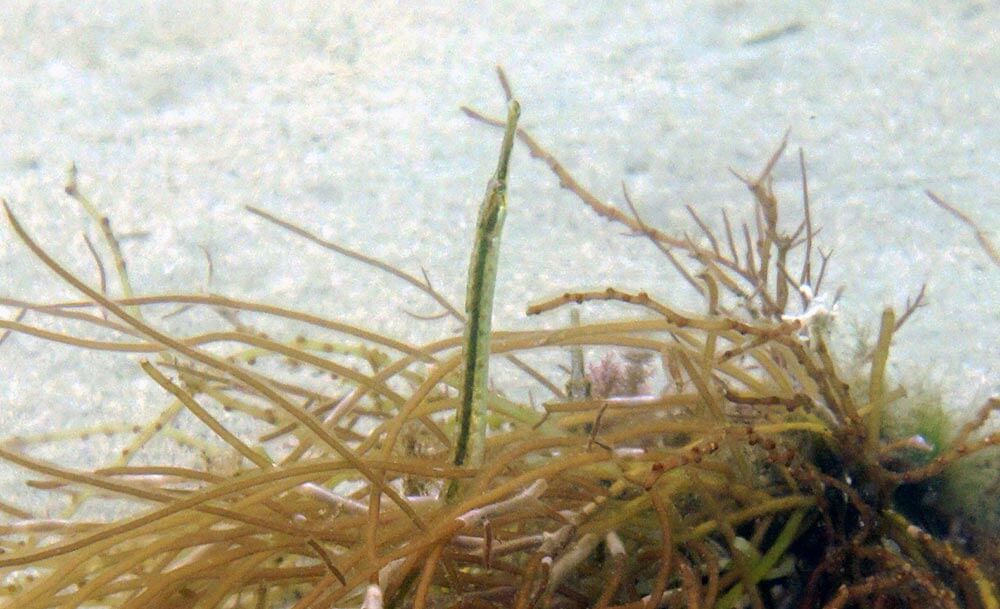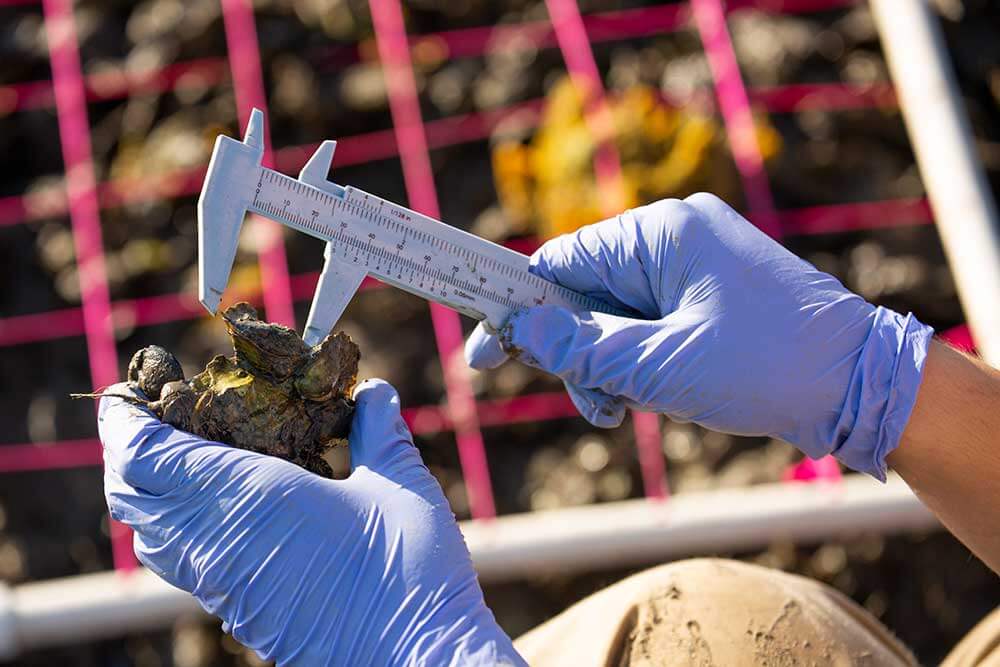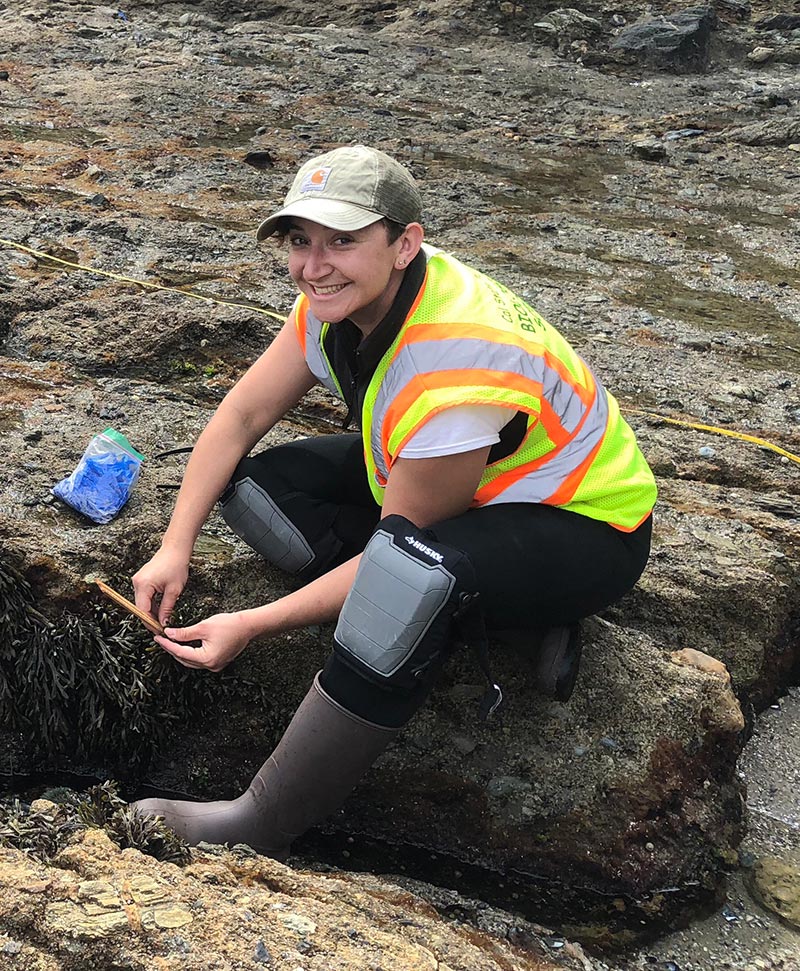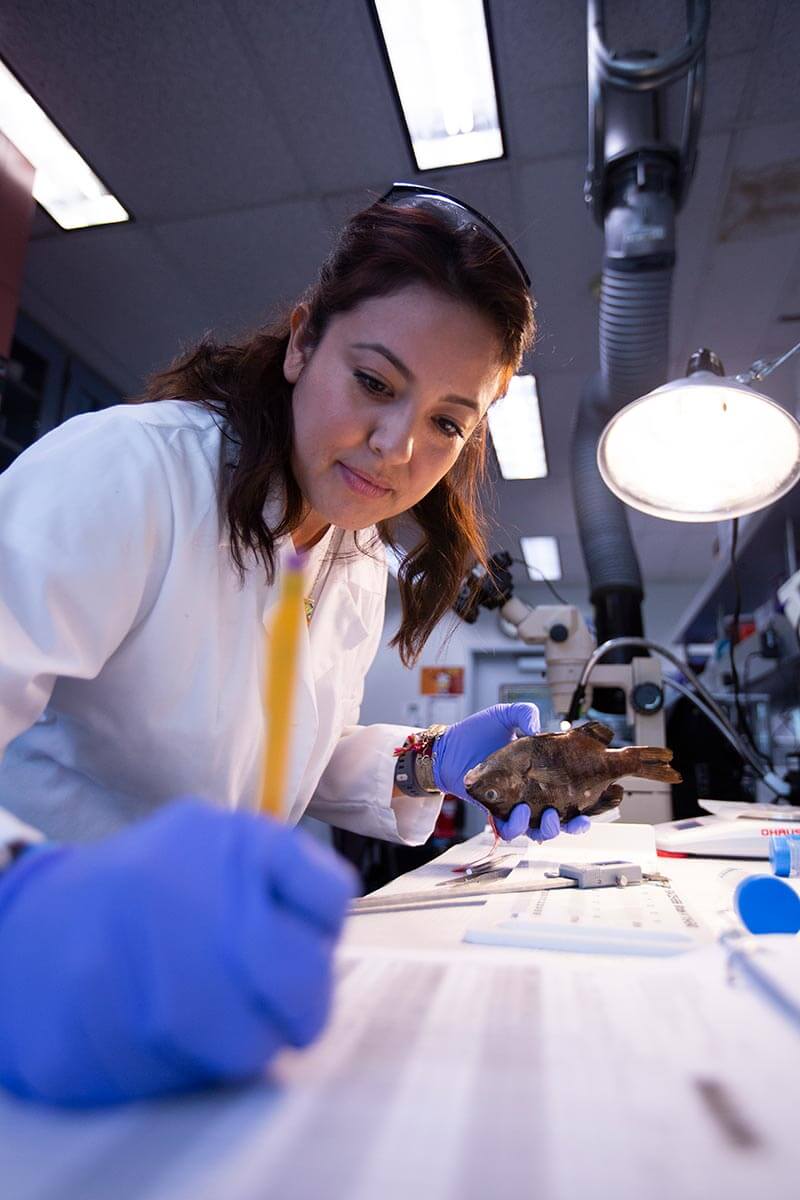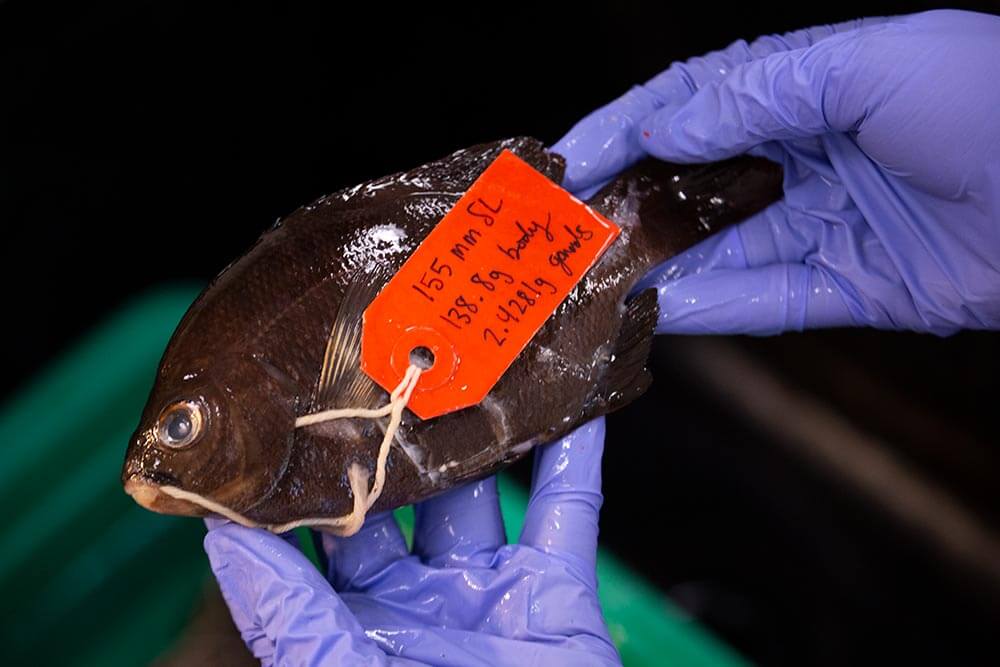Whether it's restoring the habitat of native Olympia oysters, exploring how seaweed ecosystems can survive with rising sea levels, understanding the evolution of different species of pipefish or discovering the elegance of the manta ray's filtration system, Cal State Fullerton students are taking a deep dive into marine research.
Working alongside marine biology faculty mentors, undergraduate and graduate students are involved in a multitude of research projects under the sea and in the rocky intertidal zone.
With climate change and rising sea levels threatening sea life, the researchers seek to better understand ocean organisms in an effort to protect, preserve and shore up the habitats of marine species along the Southern California coast.
"Our marine biology faculty and students work together to answer a variety of ecological, evolutionary, biophysical and physiological questions," says Sean Walker, interim associate dean of the College of Natural Sciences and Mathematics and professor of biological science. “Through immersive research experiences, students are building skills, applying the principles of investigation and finding solutions to the challenges facing our coastal and marine environments to become the marine scientists of the future."
Researchers also are investigating the biomechanics of certain fishes, including the kite-shaped manta ray, and how its unique filtration system could be applied to real-world, practical uses, such as curbing plastic pollution in the ocean.
Manta Ray's Magnificent 'Ricochet' Filter
The magnificent manta ray, which can weigh thousands of pounds and has wingspans of over 20 feet, doesn't chase down and bite into prey. Instead, the giant manta ray glides along combing the sea for some of the smallest prey, capturing huge amounts of tiny zooplankton and using its gill rakers to filter food.
Biology graduate student Raj Divi and his faculty research adviser Misty Paig-Tran are examining how this marine animal's filtration system works. Their latest research, published in Science Advances, found that manta ray filters could filter large volumes of particles from the water quickly — and surprisingly, without clogging. The manta ray's distinctive mechanism for filtering particles may hold answers to better filtration systems devised by humans.
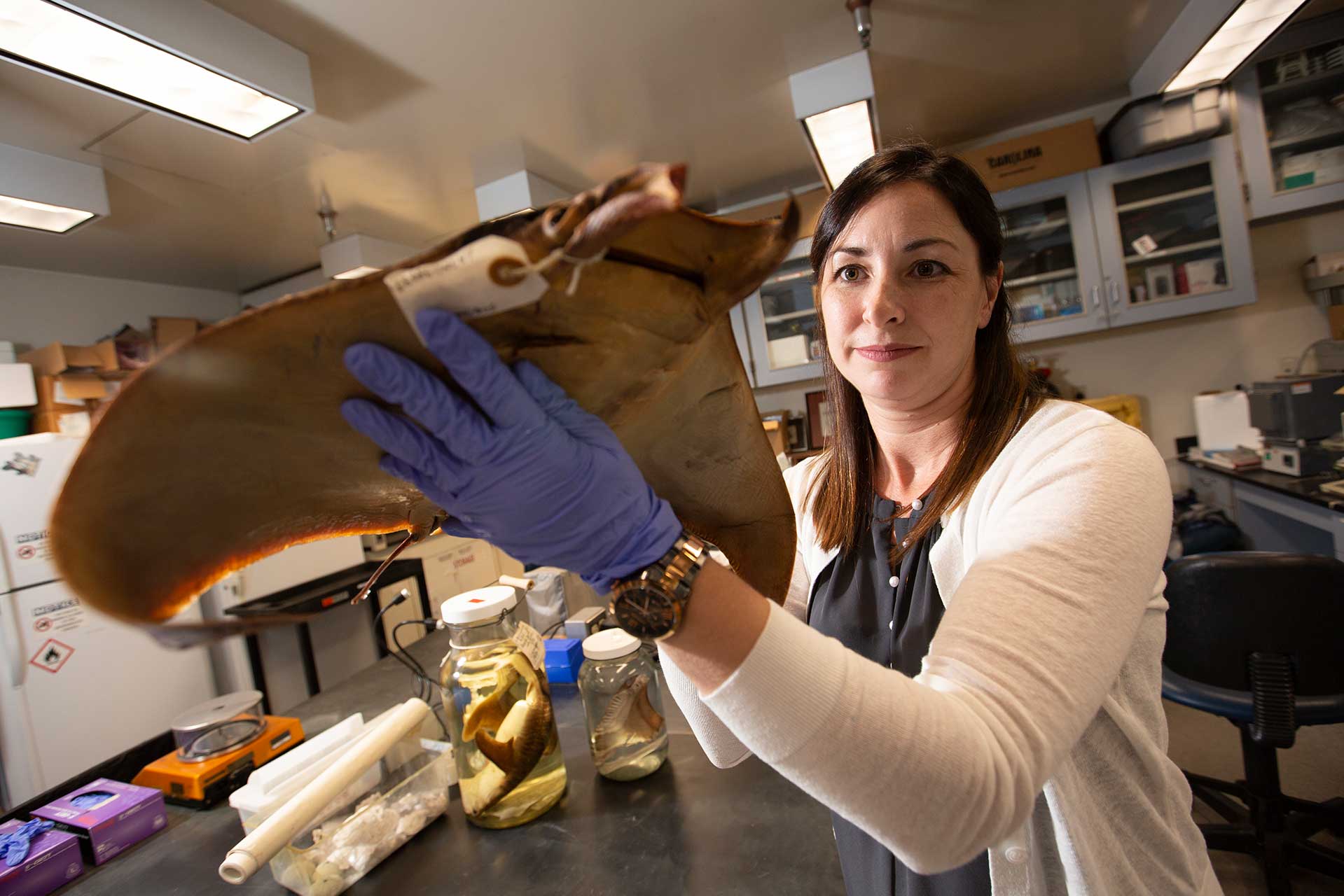
Misty Paig-Tran holds a museum specimen of the devil ray. This fish is closely related to manta rays and has similar non-clogging filters.
“Studying how manta rays filter vast quantities of particle-filled water without clogging means that we may be able to design a way to filter water in remote areas more cheaply, which could lead to fewer infectious diseases, or filter out microplastics from the ocean more efficiently using the same mechanisms," Divi explains.
Scientists assumed that manta rays use a filter that functions kind of like a pasta colander, where particles remain while water drains out.
"Our study results show that manta rays do something really tricky. They create what we have termed a 'ricochet filter' to separate food from water," explains Paig-Tran, assistant professor of biological science. She has studied mantas for more than 10 years and focuses on comparative biomechanics — the blending of engineering and biology to explore how organisms interact with the environment.
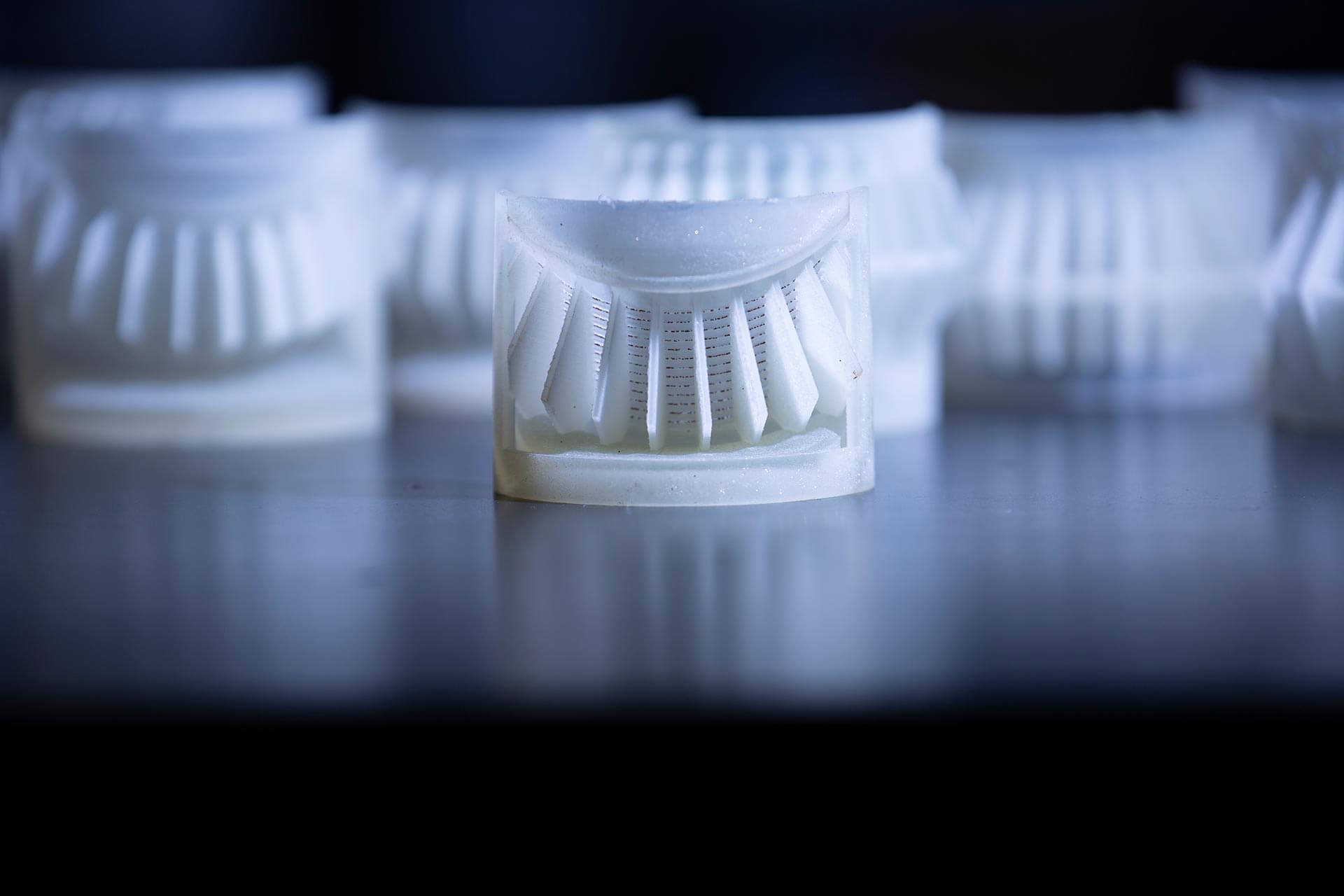
Marine biology researchers Misty Paig-Tran and Raj Divi created this 3D print of a manta ray's filter.
"Particles enter into the mouth, then ricochet off the filter surface and back toward the esophagus, while water takes a different path and exits out the gill slits. It is very sophisticated and cool — and important from an engineering perspective."
Some of the other research projects Paig-Tran and her students are tackling include studies on whale shark filtration, what bulbous bones on oarfish are used for, and how walruses haul out of ice sheets on their teeth.
Fish Forensics
In rocky intertidal regions, the area between the sea and the shore, rocks collect pools of seawater in their crevices as the water recedes for the low tide, forming tidepools. These tidepools are homes and temporary shelters for a wide range of marine organisms, such as mussels, crabs, snails, barnacles, small fish and various types of algae.
"Many of these organisms can only be found in these regions and are susceptible to negative human impacts, which is what makes tidepool conservation so important," says undergraduate Shannon Chou.
Chou is studying tidepools along the Orange County coastline, where these living marine organisms pass through or settle down, leaving traces of their presence in the form of skin cells, urine and blood. These signatures are sources of genetic material known as environmental DNA (eDNA) because they are taken from the surroundings rather than individual organisms, notes Chou, a biological science major.
Her research, under the mentorship of faculty members Jennifer Burnaford and Ryan Walter, focuses on whether the use of eDNA analysis is a plausible alternative to traditional and more intrusive methods of surveying species composition and diversity in tidepools.
"Marine life in a tidepool can change extensively from one tide to the next, so it is in our interest to examine what the range and scope of eDNA detection is in that environment," she explains.
Chou, a scholar in the Southern California Ecosystems Research Program, characterizes her project as the first to investigate eDNA from the intertidal region along the local coast.
Aggressive Sea Anemones
Alexis Barrera has spent many days and nights out at the rocky coastline in Laguna Beach collecting sea anemones — tiny invertebrates that don't have a backbone, which are closely related to jellyfish and coral.
Her project focuses on Anthopleura elegantissima, a species of intertidal sea anemone with some pretty cool characteristics, says Barrera, a biology graduate student working with Burnaford, associate professor of biological science.
"Individuals can split themselves in half, creating a genetically identical clone and create these large groups of densely packed clonemates in the intertidal zone," explains Barrera, recipient of a 2018 Graduate Student Research Fellowship from the California State University Council on Ocean Affairs, Science and Technology.
Barrera is investigating the relationship between the sea anemone's environmental conditions and their aggressive behavior. "These anemones are very territorial, so when a non-clonemate enters the territory of an opposing clone, a battle ensues, complete with inflatable weaponized tentacles and no-man’s land."
As intertidal organisms, the anemones also experience daily fluctuations in temperature and aerial exposure as the tide comes in and recedes, putting them at risk of heat stress or drying out, Barrera adds. Her research so far has shown that air and water temperatures, as well as aerial exposure, affect their aggressive behavior.
"The sea anemone is an important species in the intertidal zone. A change to their borders could lead to a change of the distribution of multiple other species in the intertidal zone."
In Pursuit of Pipefish DNA
To assess paternity or gauge population structure of pencil-thin pipefishes, biological science major Brian Bartter dives up to 40 feet into the waters near Redondo Beach.
Pipefish are closely related to seahorses. They are not very strong swimmers, and instead rely on their shape and color to remain camouflaged within seaweeds on the ocean's sandy bottom, Bartter notes. Like seahorses, pipefishes have reversed sex roles, with the males becoming pregnant and carrying around their young.
Bartter and his faculty mentor Walter, assistant professor of biological science, have developed molecular genetic markers using DNA fingerprinting techniques, similar to those commonly employed in forensic science, to identify pipefish individuals and determine the levels of genetic similarity among groups of pipefish. In California, there are four very closely related pipefish species. The researchers hope their genetic assays can provide greater resolution among these species, which are challenging to identify in the field.
"We are aiming to test our molecular methods using non-invasive and non-destructive sampling, such as swabbing individuals in the field rather than tissue sampling," Bartter explains. "These methods will allow us to track individuals over the course of a season to establish patterns of relatedness and diversity among individuals at sites like Redondo Beach."
Ultimately, their work may uncover local and regional genetic structures in these fish species, which, to date, are relatively unknown. "We will be able to refine our current understanding of the morphological differences among species and their corresponding genetic signatures," Bartter adds.
Saving the Olympia Oyster
Since prehistoric times, Olympia oysters have lived in Southern California's estuaries. Over-harvesting, pollution, disease, climate change and habit destruction have contributed to significant declines of native oyster species over the last 200 years.
In the middle of the night, biology graduate student Victoria Wood and scores of other students, under the guidance of faculty mentor Danielle Zacherl, associate professor of biological science, work on restoring the Olympia oyster's habitat.
Wood's research in the Upper Newport Bay focuses on both ecosystem restoration and shoreline resiliency by constructing oyster reefs and eelgrass beds as a living shoreline initiative. Living shoreline initiatives strive to use natural structures, such as rocks and vegetation, to increase shoreline resiliency and buffer erosion caused by climate change, including rising sea levels.
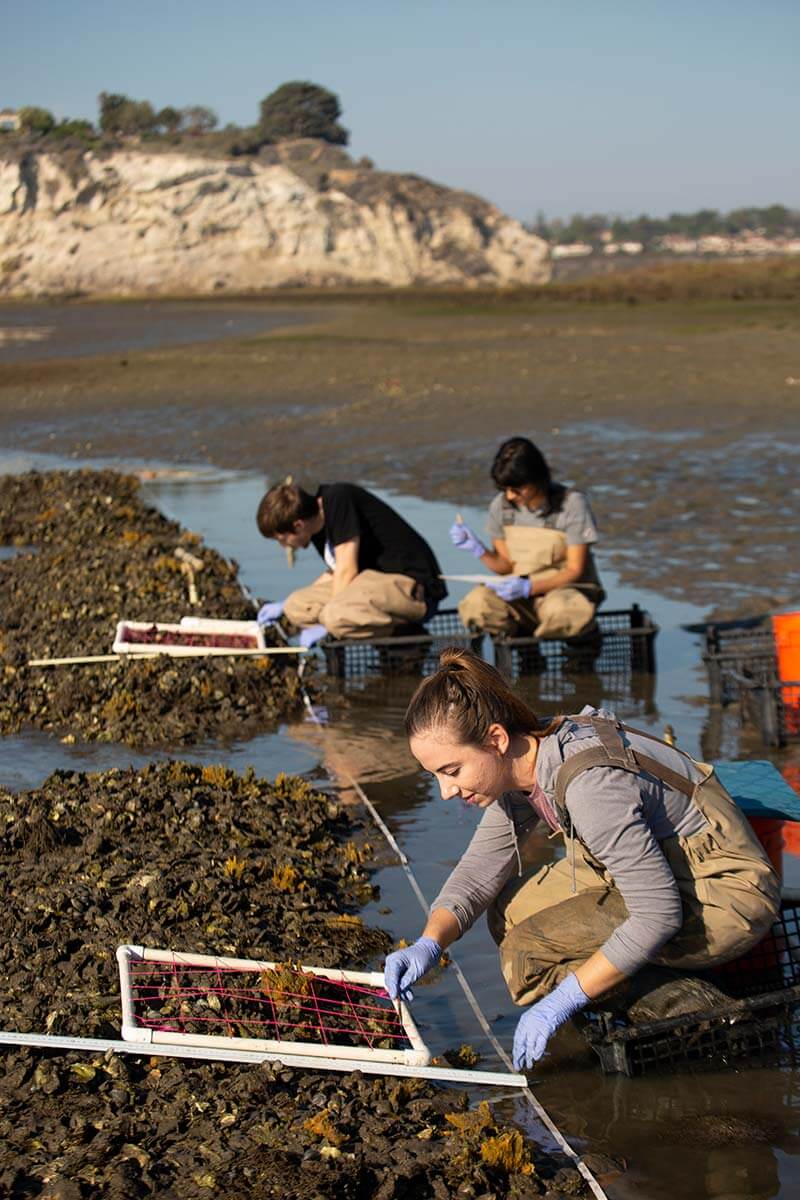
Students Victoria Wood (forefront), Mayra Rodriguez and Eric Stucker monitor the Olympia oyster beds in the Upper Newport Bay.
"This project, in particular, seeks to restore oysters and eelgrass, together and in isolation," Wood adds.
The researchers hope to improve shoreline stabilization and also reduce erosion. Oyster restoration is important for a number of other reasons, but notably because oysters feed on phytoplankton.
"Oysters provide the ecosystem service of filtering phytoplankton out of the water column that might cause algal blooms, which threaten both human health and the health of organisms in the ocean," Wood notes. "Eelgrass restoration is also important because it increases dissolved oxygen through photosynthesis, and subsequently sequesters carbon. Both oysters and eelgrass provide a complex three-dimensional habitat for other organisms to live."
Seaweed Survival
For some, squishy, slimy seaweed may seem inconsequential. But the ocean algae are important parts of the intertidal ecosystem and food chain. Seaweeds provide habitat and food for many marine animals, says Ariel Heyman.
"If anything weird happens to the seaweeds, it affects many other creatures as well," the biology graduate student points out.
Under the mentorship of Burnaford, Heyman is studying a particular type of seaweed called Pelvetiopsis californica, a fleshy brown alga that lives high up in the rocky intertidal zone and is used to spending about 15 hours a day out of the water during low tides.
Due to climate change and sea level rise, intertidal zones — and the sea animals and plants that thrive in these coastal settings — are threatened, notes Heyman, a former high school biology teacher. "With the sea level expected to rise, this seaweed will suddenly be underwater for most of the day."
For her study, she is transplanting seaweeds from high up on the rocks to closer to the ocean to simulate sea level rise at sites in Newport Beach. Seaweeds will be out of the water for only about four hours a day, compared to the usual 15 hours.
"I will be looking at how these seaweeds that I transplant survive, photosynthesize and reproduce for the next year," she says. "This research will give us an idea of whether our local rocky intertidal communities have a chance of surviving climate change."
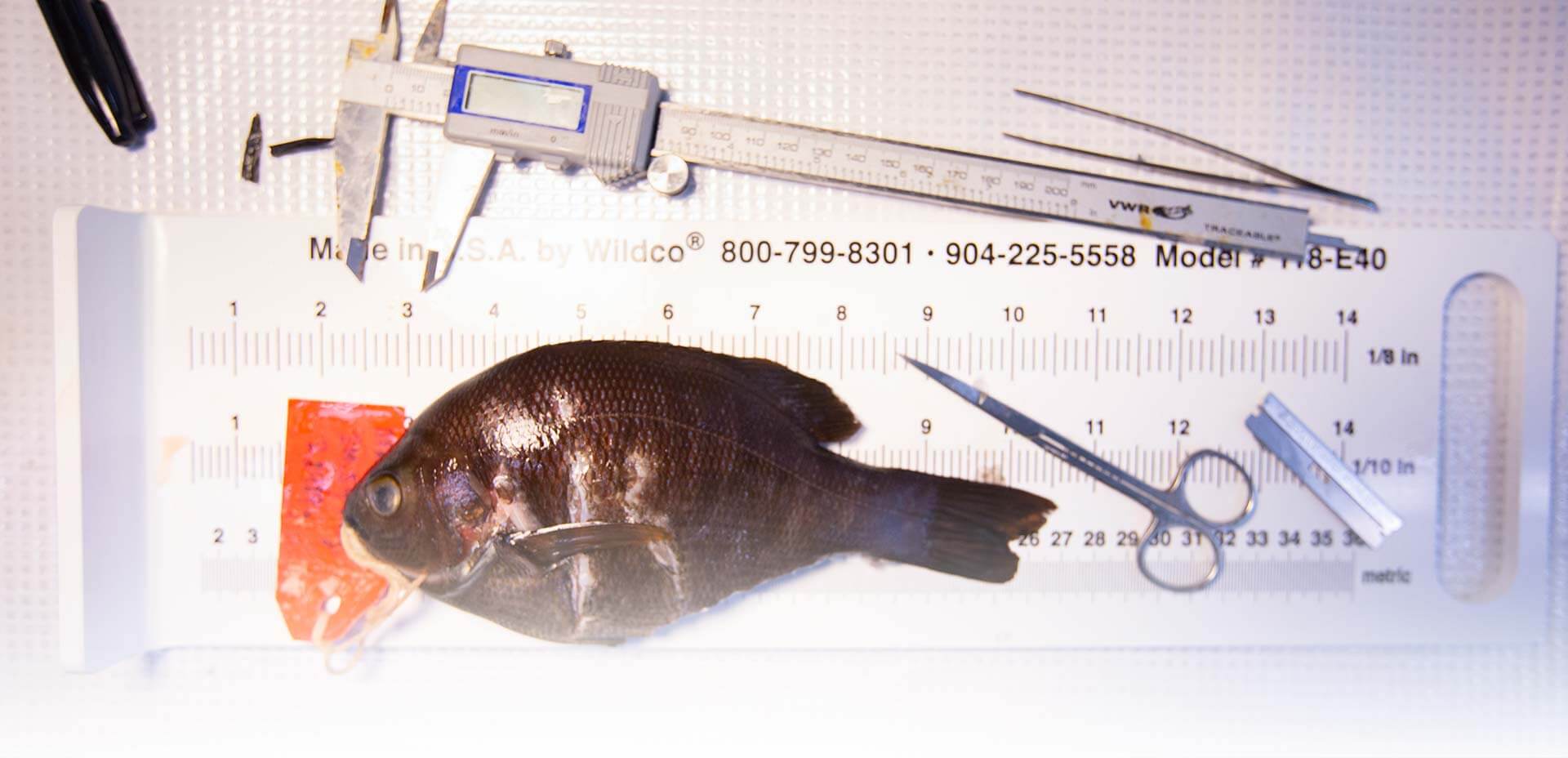
Surfperch Reproduction
Using a 50-foot fishing net, Evelyn Bond and fellow student researchers walk 50 to 100 feet into shallow water and set up parallel to the seashore. Dropping the net, they drag it and walk out of the ocean toward the seashore to corral oval-shaped surfperch in the net for study.
The biology graduate student, with research mentor Kristy Forsgren, associate professor of biological science, is examining the reproductive physiology of surfperches, which live near shore and reproduce through internal fertilization.
"Males use an external structure to deliver sperm into the female reproductive tract," relays Bond, recipient of a prestigious National Science Foundation Graduate Research Fellowship to support her research.
For her study, Bond uses innovative techniques, such as scanning electron microscopy, to identify and understand reproductive structures and mechanisms in surfperches. She also is collaborating with the Natural History Museum of Los Angeles to access their fish collections for her project.
Through her investigation on surfperches, Bond hopes to contribute to the greater scientific community by expanding knowledge about fish reproductive anatomy and physiology, and also hone her scientific skills.
"My confidence as a Mexican-American woman in the field of science has significantly grown," she continues. "Dr. Forsgren has motivated me to reach higher than I could ever have imagined."
 California State University, Fullerton
Deep Dive Into Marine Life
California State University, Fullerton
Deep Dive Into Marine Life
 Intro
Intro
 Manta Ray's Magnificent 'Ricochet' Filter
Manta Ray's Magnificent 'Ricochet' Filter
 Fish Forensics
Fish Forensics
 Aggressive Sea Anemones
Aggressive Sea Anemones
 In Pursuit of Pipefish DNA
In Pursuit of Pipefish DNA
 Saving the Olympia Oyster
Saving the Olympia Oyster
 Seaweed Survival
Seaweed Survival
 Surfperch Reproduction
Surfperch Reproduction
